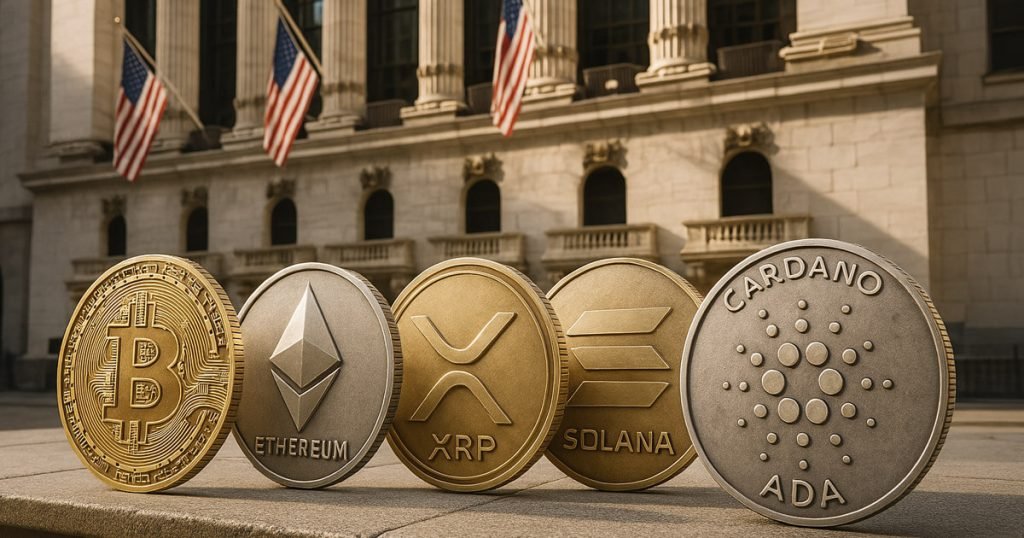Grayscale Moves Towards ETF Approval with S-3 Filing
Grayscale Investments, a leading digital asset management firm, recently filed an S-3 Form with the U.S. Securities and Exchange Commission (SEC) on April 1, signaling its intention to register the Grayscale Digital Large Cap Fund (GDLC) as an exchange-traded fund (ETF). This move is crucial as ETFs allow investors greater access to various asset classes, including cryptocurrencies. The filing aligns with the Securities Act of 1933, which permits specific issuers who meet established reporting criteria to register their securities for public sale, either immediately or at a later time.
The road to approval involves multiple regulatory steps. Notably, on October 15, 2024, NYSE Arca submitted a separate application (19b-4) to list shares of GDLC on the exchange. Currently, this application is under the review of the SEC. Grayscale has emphasized that it will not proceed with any offerings related to the GDLC unless the SEC grants approval for its NYSE Arca listing. This establishes a clear timeline for potential investors as the SEC’s decision-making clock started once the 19b-4 application was filed, with initial deadlines set for May 3 and a final decision expected by July 2.
The conversion of the GDLC into an ETF could have implications beyond Grayscale itself. For instance, Bitwise Asset Management is also awaiting regulatory action on its Bitwise 10 Crypto Index Fund conversion filing. Historically, SEC decisions on similar applications tend to occur in batches, meaning that the approval for Grayscale’s ETF could pave the way for other digital asset funds seeking similar conversions.
Strategic Composition of the GDLC Fund
Grayscale’s GDLC is strategically composed of five cryptocurrencies: Bitcoin (BTC), Ethereum (ETH), XRP, Solana (SOL), and Cardano (ADA). These assets were notably mentioned by former President Donald Trump when he suggested the notion of a digital asset stockpile. While the fund’s initial composition is grounded in these top cryptocurrencies by market capitalization, the manager retains the discretion to periodically rebalance the fund and exclude certain assets as deemed necessary.
This strategy of asset management is essential for maintaining the integrity and performance of the fund in a rapidly changing market. The selection of these particular cryptocurrencies is not without scrutiny. “Crypto Czar” David Sacks, in a Bloomberg Technology interview, mentioned that discussions around Trump’s remarks might be reading into matters too deeply. He clarified that the specific cryptocurrencies mentioned were picked due to their significant standing in terms of market cap rather than any political agenda.
A Presidential Executive Order and Its Implications
The executive order signed by Trump on March 7 formalized the establishment of a Digital Asset Stockpile, which comprises all altcoins currently held by U.S. authorities. This order potentially sets a precedent in the regulatory landscape surrounding cryptocurrencies and digital assets in general, reinforcing the idea that the government acknowledges and engages with the burgeoning market of digital currencies.
While some may interpret the president’s comments as an endorsement of these particular cryptocurrencies, industry insiders argue that the focus should remain on the market dynamics rather than political implications. This understanding is crucial for prospective retail and institutional investors as they navigate the complexities of crypto investments within regulatory frameworks.
Potential Impact of ETF Conversions on Cryptocurrency Adoption
The potential approval of GDLC as an ETF stands to enhance the legitimacy and acceptance of cryptocurrencies among traditional investors. ETFs typically provide a lower barrier to entry for retail investors who may be hesitant about directly purchasing cryptocurrencies through exchanges. As institutional adoption grows, the establishment of ETFs reflects a broader acceptance of digital assets within mainstream finance.
Furthermore, the increased availability of crypto ETFs could lead to a higher volume of investments within the cryptocurrency ecosystem, driving demand and potentially influencing price trends. The wider acceptance of cryptocurrencies through regulated products could facilitate the entry of more players into the digital economy, promoting innovation and development within the blockchain sector.
Conclusion: What Lies Ahead for Grayscale and Other Crypto Firms
As Grayscale awaits the SEC’s decision, all eyes are focused on the outcome of the GDLC’s ETF application. The importance of this moment in the cryptocurrency landscape cannot be overstated; a successful transition to an ETF could serve as a catalyst for further regulatory clarity and acceptance.
With Grayscale’s proactive approach and the strategic framing of its fund, plus the backing of prominent digital currencies, the future looks promising for both the firm and the broader crypto market. If successful, the GDLC ETF could not only establish a benchmark for other firms like Bitwise but also redefine how investors interact with cryptocurrencies, making them a standard component in diversified investment portfolios.
In conclusion, the integration of cryptocurrency-based ETFs could significantly alter the financial environment, further legitimizing digital assets and solidifying their place in investment strategies moving forward. Given the anticipated regulatory changes, we will monitor how these developments unfold and their eventual impact on both institutional and retail investors in the cryptocurrency market.


